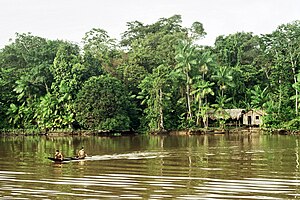 Image via WikipediaBy David Walch
Image via WikipediaBy David WalchThe Amazon Rainforest is home to numerous species that make up twenty percent of those found on the planet. Covering an area of two and a half million square miles, representing two-thirds of South America, the Amazon Rainforest expands into nine countries: Brazil, Colombia, Peru, Venezuela, Suriname, Ecuador, French Guiana and Guiana.
The Amazon Rainforest, considered to be the world's largest natural resource, constitutes over fifty percent of the earth's total rainforest. Known as the earth's lungs it produces over twenty percent of the Earth's oxygen; more than any other single source. As such, it is a vital source of the air that we breathe.
Its' canopies are home to the iconic toucan with its' thick, short neck and its large colourful beak in combinations of red, black, blue, white and red. Additionally, the Amazon Rainforest hosts over one third of the total bird species found on Earth. Many of which are in danger of extinction due to mans encroachment on and deforestation of the rainforest.
In addition to its abundant avian population, the Amazon Rainforest is also home to the capybara. At two feet tall and weighing in at over one hundred pounds, the capybara it is the planet's largest rodent. An endangered species, it is an excellent swimmer, spending most of its' days, and nights, in and under the water. The capybara exists primarily on a diet of aquatic vegetation, melons, squash and grass.
The Amazon Rainforests largest mammal is not a land animal, as you might suspect, but lives in the Amazon River and its' tributaries, the Amazonian manatee. Also known as sea cows (a reputation earned from its herbivorous habits and spending most of its days grazing). Some have even supposed they saw mermaids when encountering the Amazonian manatee.
Considered the most beautiful of all the Amazon Rainforest's creatures is the mythical Amazon pink river dolphin. Suffering from the effects of development of the Amazon Rainforest, the Amazon pink river dolphin is a severely endangered species due to the pollution of its' habitat from agriculture, mining and industry. Local fishermen do not see the dolphin for its beauty due to its habit of tearing holes in their nets to steal their catch.
A beautiful, but deadly, Amazon Rainforest resident is the jaguar. An excellent hunter, and natural athlete, the jaguar grows to up six feet long and can weigh as much as two hundred pounds. Naturally adept on land or water, the jaguar can climb trees or run in search of its prey, or swim after aquatic prey such as the pirarucu or turtles.
A less attractive, but just as dangerous, Amazon Rainforest resident is its largest predator, the black caiman. With no natural enemies, other than man, it can grow to as large as twenty feet in length and weigh in at over three thousand pounds. It has been known to eat the likes of giant river otters, capybara and even humans.
Of course the Amazon Rainforest, with its diverse animal population, is home not only to large predators, but also the nearly microscopic. One of the most deadly of which is the poison arrow frog. Harmless if left alone it possesses the most powerful toxin known to man. Its toxin can kill as many as one hundred people. The Amazon Indians have long harvested the frog for its poison, which they use on the tips of their arrows when hunting.
The Amazon is a healthy environment for the fabled anaconda, which grows its entire life. The largest ever caught was approximately twenty eight feet long with a girth of forty four inches and estimated to weigh nearly five hundred pounds.
The most infamous of all the Amazon Rainforest's wildlife is undoubtedly the piranha. The most feared and best known of all Amazon rainforest's creatures is the red bellied piranha. Feeding in large schools they can converge upon, and devour with their razor sharp teeth, such prey as caimans, anacondas and jaguars. However, contrary to popular myths attacks on humans are extremely rare.
Article Source: http://EzineArticles.com/?expert=David_Walch
http://EzineArticles.com/?The-Amazon-Rainforest:-A-Cornucopia-Of-Wildlife&id=5962534

No comments:
Post a Comment